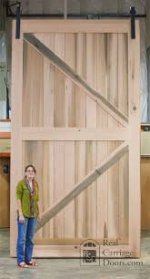Neathawk Designs said:
They definitely want the door on hinges.
In the photo above, I was thinking that each section of T&G should be its own panel... Does this make sense? There would be 4 triangular panels in this case. There is a slight possibility of incorporating circles into this as well. I will find out more tomorrow.
Hinges can work- they just have to be engineered/sized properly. Having said that, there's a reason why so many barn doors are sliders and I'm inclined to agree with posters here that a slider is a good way to go in this case.
If they absolutely have to have hinges, it's ESSENTIAL that both of the diagonal braces on the door frame start with the high end on the latch side (latch stile) and finish with the low end on the hinge side (hinge stile) of each door. The diagonal braces keep the door from sagging.
The top, middle, and bottom rail, the braces, and the hinge and latch stile are your structure.
The panel's primary purpose is as a barrier between the inside and outside and its structural function is secondary to that.
You'll want the panels attached to the backside (inside) of your structural frame. Therefore, you could build a top and a bottom or just one large panel. Either way it will be square or rectangular and not the triangular shape you're mentioning.
Take a look at 'breadboard ends' on google and think about that as a top and a bottom for your panel, affixed to the back of your frame.
You could T&G the panel planks and then T&G their ends where they meet the breadboard ends.
If you fasten the center plank of your panel at the top bottom and middle and then fasten the outer two planks with slots rather than holes, you can let the rest of the panel float. The planks are tongue and grooved to each other and then their tongues are let into the breadboard ends' grooves. At this point you've done quite a lot to prepare for seasonal movement in the panel.
This isn't the only way to do it but it will give you some ideas. Best of luck on the meeting tomorrow!
Dave 8)

